PET Packaging Market Size
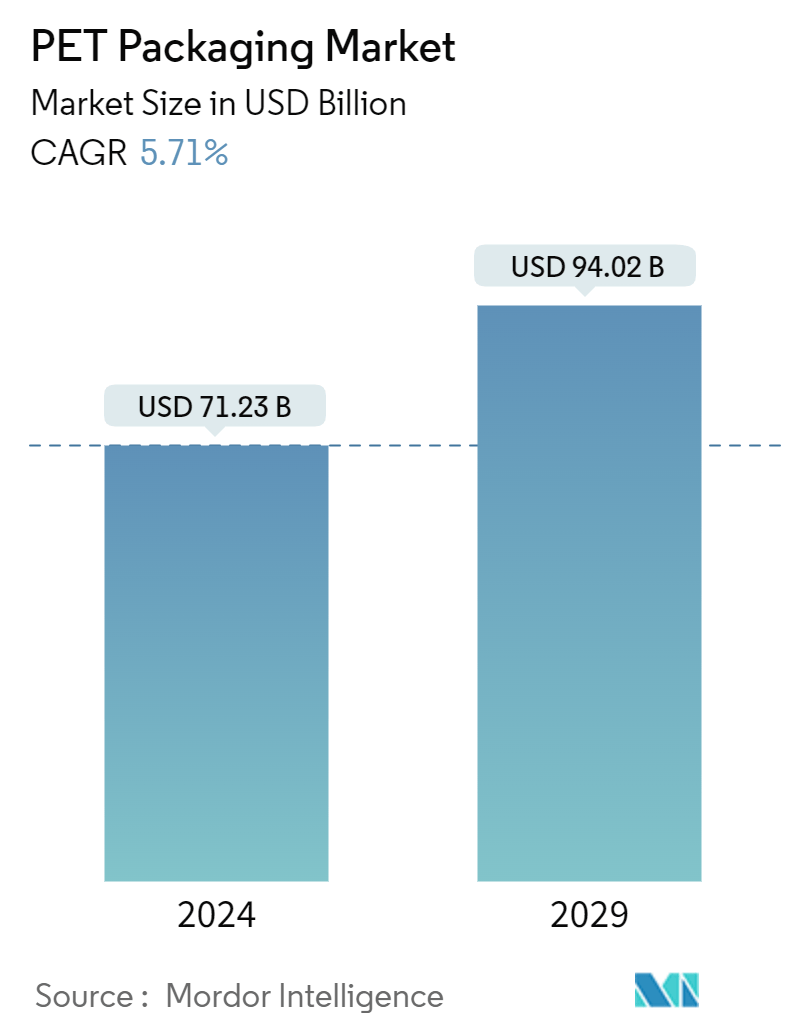
| Study Period | 2019 - 2029 |
| Market Size (2024) | USD 71.23 Billion |
| Market Size (2029) | USD 94.02 Billion |
| CAGR (2024 - 2029) | 5.71 % |
| Fastest Growing Market | Asia-Pacific |
| Largest Market | North America |
Major Players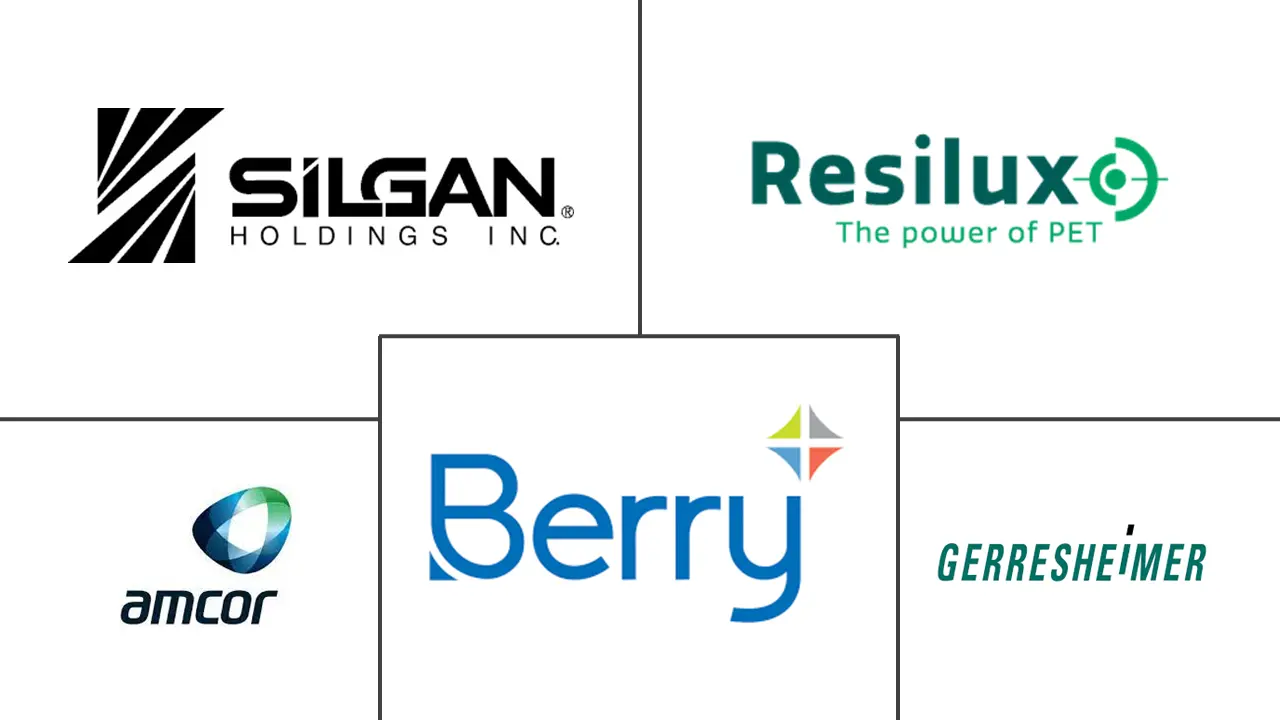
*Disclaimer: Major Players sorted in no particular order |
PET Packaging Market Analysis
The PET Packaging Market size is estimated at USD 71.23 billion in 2024, and is expected to reach USD 94.02 billion by 2029, growing at a CAGR of 5.71% during the forecast period (2024-2029).
The increasing demand for environmentally friendly packaging solutions and the outstanding properties of PET are expected to drive the growth of the global PET packaging market over the forecast period.
- The packaging sector keeps making significant strides in environment-friendly technologies to satisfy customer demand for a more sustainable society. Customers increasingly know that high-performance packaging may lengthen a product's shelf life. This awareness has increased the need for environment-friendly end-of-life packaging options, particularly PET (polyethylene terephthalate) packaging solutions.
- PET can result in weight reductions of up to 90% compared to glass, making shipping more affordable. As they provide reusable packaging for beverages like mineral water, PET plastic bottles have increasingly replaced bulky, brittle glass bottles in recent years.
- Several advancements and trends in how companies and products use PET indicate the attention on PET and the market's growth. PET has many uses and is easily blown into bottles or shaped into sheets due to its clarity and built-in CO2 barriers. PET characteristics can be enhanced with colorants, UV blockers, oxygen barriers/scavengers, and other additives to create bottles that meet a brand's requirements.
- PET containers are often used for packaging goods, including tennis balls, juice, salad dressing, cooking oil, peanut butter, liquid hand soap, and soda. PET is primarily used to make single-serving and two-liter bottles of carbonated soft drinks and water distributed throughout the nation, including the United States. Containers for take-home prepared meals that may be warmed in the oven or microwave are made of exceptional grades of PET.
- Most water and soft drink containers are constructed of highly recyclable polyethylene terephthalate (PET). However, attempts to collect and recycle the bottles to prevent them from damaging the oceans are falling behind as their use increases globally. For instance, if a PET bottle had 40%-60% recycled content, its emissions would be decreased by 32%-48% compared to one made from virgin material, according to a study examining the effects of single-use and reusable bottles for carbonated soft drinks.
- The COVID-19 pandemic provided significant relief to single-use packaging vendors. Although many countries were slowly banning these packaging and promoting reusable packaging, the pandemic changed consumer and government behavior. Due to COVID-19, the demand for nutritional drinks and healthy food increased exponentially. Most of these products are packaged with single-use plastic, such as PET.
PET Packaging Market Trends
Bottles Segment to Witness Significant Growth
- The high barrier qualities of polyethylene terephthalate (PET) against water vapor, gases, diluted acids, oils, and alcohols make it a common material for food packing. Moreover, PET is easy to recycle, reasonably flexible, and shatterproof. According to Earth Day organizers, one million plastic bottles are purchased in the United States every minute. The average American drinks in 167 plastic water bottles annually. Due to the region's growing need for packaged drinking water, there is an increasing market for PET plastic tops and enclosures.
- PET, derived from PE, offers excellent stiffness compared to other types of plastic. In addition, it keeps a robust protective structure and possesses extraordinary moisture resistance abilities. PET is used to make disposable plastic containers that are also used for packaging frozen or ready-to-eat foods. PET is well-liked because it provides a sound oil barrier, which helps the material fend off chemicals that could harm it.
- The expanding e-commerce sector also contributes substantially to the market's expansion worldwide. Numerous brands are employing PET more frequently because it is simple to carry PET bottles and jars from a logistics perspective. Because PET bottles are lightweight and do not need to be handled carefully, the cost of transportation is greatly diminished. Therefore, it is projected that the demand for PET packaging will be supported over the forecast period by people's growing propensity toward online shopping.
- The demand for PET for creating bottles and jars is anticipated to increase significantly due to the rising demand for food and beverage items worldwide. In addition, the packaging of hand sanitizers in PET bottles saw a rise in demand in the healthcare sector. It is anticipated to stay high, fuelling the expansion of PET bottles for hand sanitizer packaging.
- Several advancements and trends in how companies and products use PET demonstrate the focus on PET and the expansion of its market share. PET has many uses and is easily blown into bottles or shaped into sheets. PET characteristics can be enhanced with colorants, UV blockers, oxygen barriers/scavengers, and other additives to create bottles that meet a brand's requirements.
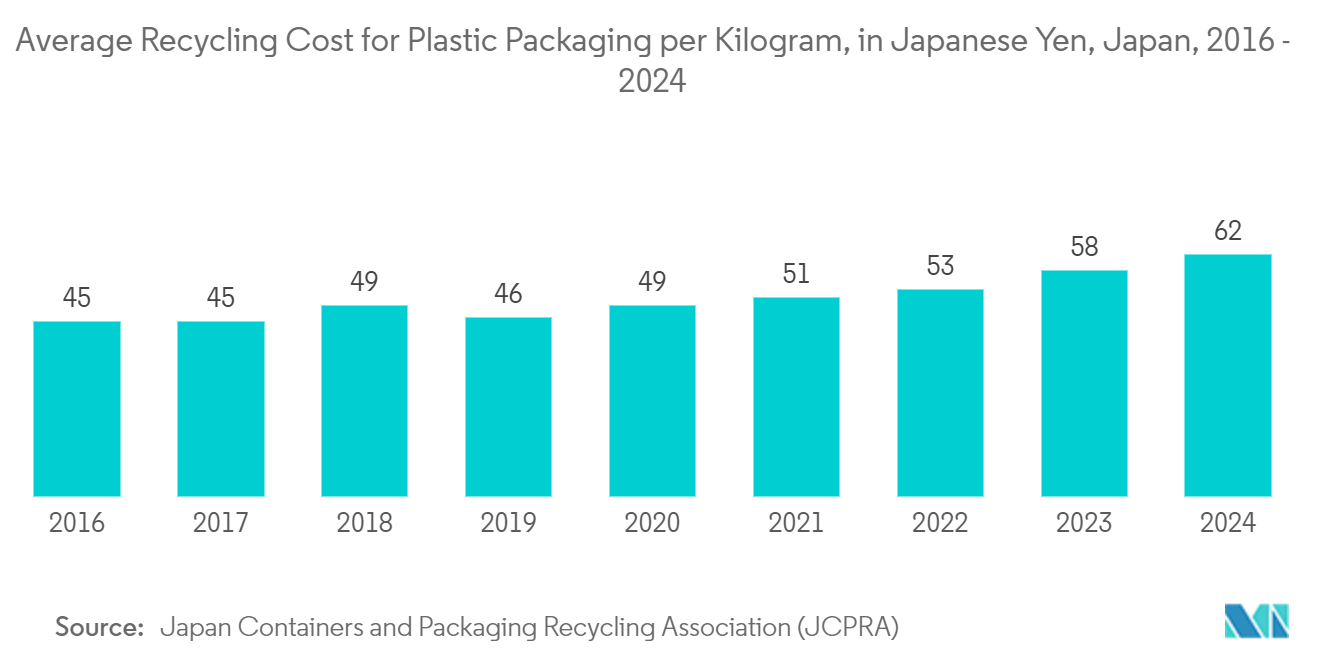
Asia-Pacific to Register Significant Growth in the Market
- China is among the largest polyethylene terephthalate (PET) markets worldwide. For the past few years, the country's growing production of engineering plastics, such as PET, has been aided by the plentiful availability of raw materials and low cost of manufacture. The demand for PET bottles in China is constantly rising. It is obvious how critical soft drinks are to PET packaging’s growth in China. It is significantly influenced by the bottled water industry and its key players, like Master Kong and Nongfu Spring, as well as the significant rise in bottled water consumption in China yearly.
- Due to PET's benefits over the currently utilized traditional packaging polymers, the usage of PET goods in the packaging sector (PET containers and bottles, among others) is increasing. Due to rising exports and domestic consumption, packing materials are in higher demand in China from sectors including the food and beverage industry, consumer goods, and others.
- A variety of plastics, including polypropylene (PP), polyethylene terephthalate (PET), polyvinyl chloride (PVC), and others, are produced in India. India has a massive capability for producing PET, and most of the domestic market's needs are met. However, regional differences also exist in the domestic market's consumption of PET. Due to numerous end-user businesses and a vast distribution network, the North and West of India account for most PET use.
- The demand for single-serve and small-sized goods packaged in materials like PET and metal cans has surged in India as the country adopts an on-the-go food consumption trend. Because consumers are budget-aware and look for products that provide value for money, flexible packaging materials like PET are still widely used nationwide.
- However, consumers have started gravitating toward alternate packaging materials because they have eco-friendly qualities. Due to their eco-friendliness and high capacity for recycling, glass and aluminum have seen significant acceptance rates in the region. As a result, customers are turning away from plastic in more significant numbers.
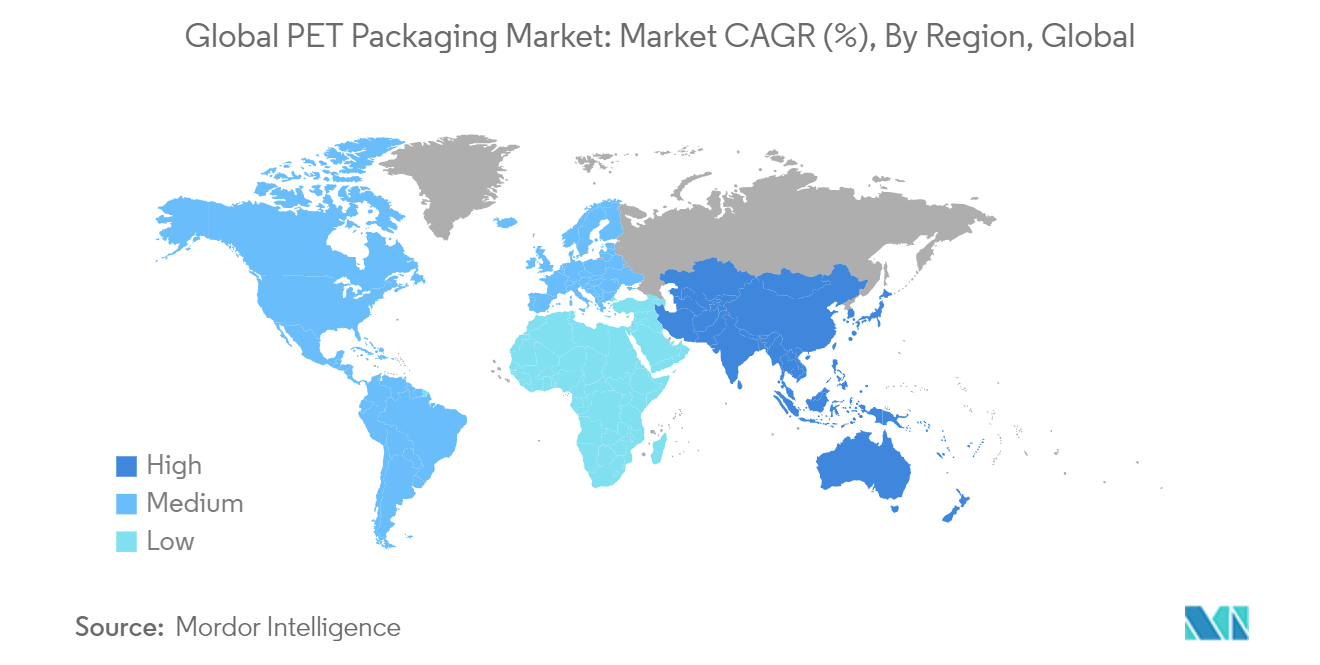
PET Packaging Industry Overview
The PET packaging market is fragmented and consists of several major players, such as Amcor Ltd, Gerresheimer AG, Berry Global Group Inc., Silgan Holdings Inc., and Resilux NV. These market players with a significant market share are concentrating on growing their international consumer base. These businesses use tactical joint ventures to raise their market share and profitability. For instance,
- In May 2024, LPLA, a plastic packaging company, unveiled a recyclable wine bottle crafted from polyethylene terephthalate (PET). This innovative solution slashes carbon footprints by a remarkable 50%, offering potential cost savings of up to 30%. Available in both 750 ml and one-liter capacities, these bottles are meticulously designed to streamline bottling and shipping operations. Notably, the 750 ml PET bottle weighs a mere 50 g, just 12.5% of the weight of its traditional glass counterparts.
- In April 2024, The Coca-Cola Co. rolled out redesigned, lighter polyethylene terephthalate (PET) bottles across its sparkling beverage range in the United States and Canada. This initiative is a key part of the company's overarching goal to foster a circular economy within its packaging realm. Notably, these bottles boast innovative shapes that significantly reduce the raw materials needed for their production. The company has crafted distinct designs for its Coca-Cola and Sprite bottles while unifying the look of its other sparkling brands and Minute Maid offerings.
PET Packaging Market Leaders
-
Amcor Ltd.
-
Gerresheimer AG
-
Berry Global Group Inc.
-
Silgan Holdings Inc.
-
Resilux NV
*Disclaimer: Major Players sorted in no particular order
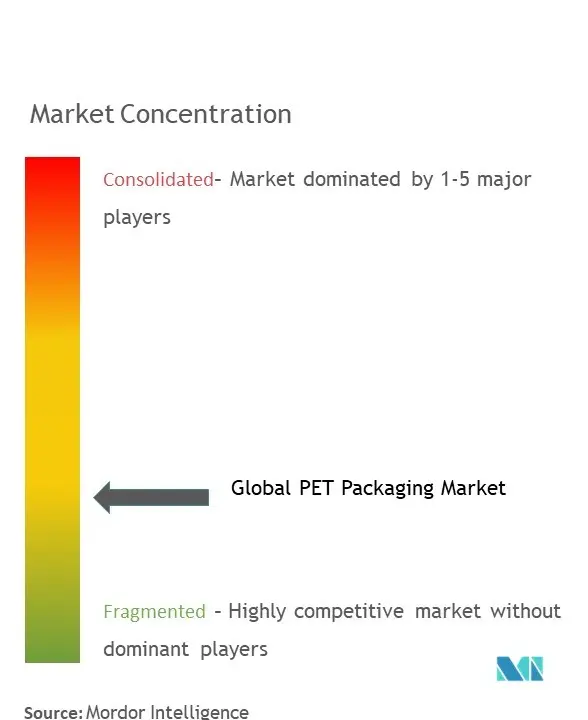
PET Packaging Market News
- January 2024: Sidel, a provider of innovative PET packaging solutions, unveiled its quality control technology for PET bottles. Branded as IntelliADJUST, this technology promises to revolutionize how customers craft PET bottles, elevating them to a new standard of excellence. This intelligent bottle-blowing control system boasts high performance while also offering user-friendly features, empowering customers to consistently achieve superior bottle quality. Notably, it facilitates the production of bottles with recycled PET (rPET) content. By leveraging interferometric sensor technology in a 'closed-loop' system, IntelliADJUST ensures impeccable material distribution, thereby enhancing production uniformity for all PET bottles, including those crafted from recycled PET.
- April 2024: Australia has set its sights on transitioning to 100% recycled content PET bottles. The Asahi Group, in alignment with this goal, is actively working to diminish its environmental footprint while ensuring the ongoing use of containers and packaging. Under the banner of '3R+Innovation' (3R stands for reduce, reuse, recycle), the Asahi Group is spearheading initiatives to meet these objectives. In a strategic move, the company forged a joint venture with packaging giant Pact Group Holdings, Cleanaway Waste Management, and beverage heavyweight Coca-Cola Europacific Partners. The joint venture has initiated the construction of Australia's largest PET recycling plant, located in Albury, New South Wales. Once operational, the plant is poised to churn out approximately 20,000 tons of recycled PET annually, translating to roughly 1 billion PET bottles.
PET Packaging Market Report - Table of Contents
1. INTRODUCTION
- 1.1 Study Assumptions and Market Definition
- 1.2 Scope of the Study
2. RESEARCH METHODOLOGY
3. EXECUTIVE SUMMARY
4. MARKET DYNAMICS
- 4.1 Market Overview
- 4.2 Introduction to Market Drivers and Restraints
-
4.3 Market Drivers
- 4.3.1 Outstanding Properties of PET
- 4.3.2 Rising Demand for Environment-friendly Packaging
-
4.4 Market Restraints
- 4.4.1 Regulations Against the Use of Plastics in Some Regions
- 4.5 Value Chain Analysis
-
4.6 Industry Attractiveness - Porter's Five Forces Analysis
- 4.6.1 Threat of New Entrants
- 4.6.2 Bargaining Power of Buyers
- 4.6.3 Bargaining Power of Suppliers
- 4.6.4 Threat of Substitute Products
- 4.6.5 Intensity of Competitive Rivalry
5. MARKET SEGMENTATION
-
5.1 By Product Types
- 5.1.1 Bottles and Jars
- 5.1.2 Bags and Pouches
- 5.1.3 Trays
- 5.1.4 Lids/Caps and Closures
- 5.1.5 Other Product Types
-
5.2 By Packaging
- 5.2.1 Rigid
- 5.2.2 Flexible
-
5.3 By End-user Industry
- 5.3.1 Food and Beverage
- 5.3.2 Pharmaceuticals
- 5.3.3 Personal Care and Cosmetic Industry
- 5.3.4 Industrial Goods
- 5.3.5 Household Products
- 5.3.6 Other End-user Industries
-
5.4 By Geography
- 5.4.1 North America
- 5.4.1.1 United States
- 5.4.1.2 Canada
- 5.4.2 Europe
- 5.4.2.1 Germany
- 5.4.2.2 United Kingdom
- 5.4.2.3 France
- 5.4.2.4 Italy
- 5.4.2.5 Spain
- 5.4.2.6 Rest of Europe
- 5.4.3 Asia-Pacific
- 5.4.3.1 China
- 5.4.3.2 Japan
- 5.4.3.3 India
- 5.4.3.4 South Korea
- 5.4.3.5 Rest of Asia-Pacific
- 5.4.4 Latin America
- 5.4.4.1 Brazil
- 5.4.4.2 Argentina
- 5.4.4.3 Rest of Latin America
- 5.4.5 Middle East and Africa
- 5.4.5.1 United Arab Emirates
- 5.4.5.2 Saudi Arabia
- 5.4.5.3 South Africa
- 5.4.5.4 Rest of Middle East and Africa
6. COMPETITIVE LANDSCAPE
-
6.1 Company Profiles
- 6.1.1 Amcor Ltd
- 6.1.2 Resilux NV
- 6.1.3 Gerresheimer AG
- 6.1.4 Berry Global Group Inc.
- 6.1.5 Silgan Holdings Inc.
- 6.1.6 Graham Packaging Company
- 6.1.7 GTX Hanex Plastic Sp. z.o.o.
- 6.1.8 Dunmore Corporation
- 6.1.9 Comar LLC
- 6.1.10 Sonoco Products Company
- 6.1.11 Huhtamaki OYJ
- 6.1.12 Nampak Limited
- *List Not Exhaustive
7. INVESTMENT ANALYSIS
8. MARKET OPPORTUNITIES AND FUTURE TRENDS
** Subject To AvailablityPET Packaging Industry Segmentation
PET, also known as polyethylene terephthalate, is a type of polyester. It is expelled or shaped into plastic jugs and boxes for packaging food and refreshments, personal care items, and several other consumer products. PET is an ethylene glycol polymer and terephthalic corrosive.
The pet packaging market is segmented by product type (bottles and jars, bags and pouches, trays, lids/caps and closures, and other product types), packaging (rigid and flexible), end-user industry (food and beverage, pharmaceutical, personal care and cosmetic industries, industrial goods, household products, and other end-user industries) and geography (North America, Europe, Asia-Pacific, Latin America, and Middle East and Africa). The market sizes and forecasts are provided in terms of value (USD) for all the above segments.
| By Product Types | Bottles and Jars | |
| Bags and Pouches | ||
| Trays | ||
| Lids/Caps and Closures | ||
| Other Product Types | ||
| By Packaging | Rigid | |
| Flexible | ||
| By End-user Industry | Food and Beverage | |
| Pharmaceuticals | ||
| Personal Care and Cosmetic Industry | ||
| Industrial Goods | ||
| Household Products | ||
| Other End-user Industries | ||
| By Geography | North America | United States |
| Canada | ||
| By Geography | Europe | Germany |
| United Kingdom | ||
| France | ||
| Italy | ||
| Spain | ||
| Rest of Europe | ||
| By Geography | Asia-Pacific | China |
| Japan | ||
| India | ||
| South Korea | ||
| Rest of Asia-Pacific | ||
| By Geography | Latin America | Brazil |
| Argentina | ||
| Rest of Latin America | ||
| By Geography | Middle East and Africa | United Arab Emirates |
| Saudi Arabia | ||
| South Africa | ||
| Rest of Middle East and Africa |
PET Packaging Market Research FAQs
How big is the PET Packaging Market?
The PET Packaging Market size is expected to reach USD 71.23 billion in 2024 and grow at a CAGR of 5.71% to reach USD 94.02 billion by 2029.
What is the current PET Packaging Market size?
In 2024, the PET Packaging Market size is expected to reach USD 71.23 billion.
Who are the key players in PET Packaging Market?
Amcor Ltd., Gerresheimer AG, Berry Global Group Inc., Silgan Holdings Inc. and Resilux NV are the major companies operating in the PET Packaging Market.
Which is the fastest growing region in PET Packaging Market?
Asia-Pacific is estimated to grow at the highest CAGR over the forecast period (2024-2029).
Which region has the biggest share in PET Packaging Market?
In 2024, the North America accounts for the largest market share in PET Packaging Market.
What years does this PET Packaging Market cover, and what was the market size in 2023?
In 2023, the PET Packaging Market size was estimated at USD 67.16 billion. The report covers the PET Packaging Market historical market size for years: 2019, 2020, 2021, 2022 and 2023. The report also forecasts the PET Packaging Market size for years: 2024, 2025, 2026, 2027, 2028 and 2029.
PET Packaging Industry Report
Statistics for the 2024 Pet Packaging market share, size and revenue growth rate, created by Mordor Intelligence™ Industry Reports. Pet Packaging analysis includes a market forecast outlook to 2029 and historical overview. Get a sample of this industry analysis as a free report PDF download.



